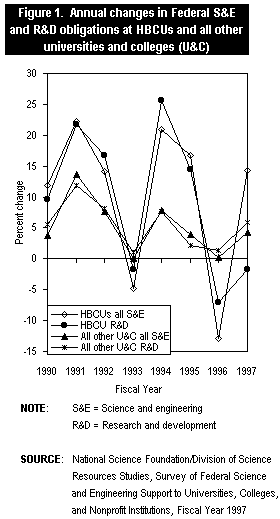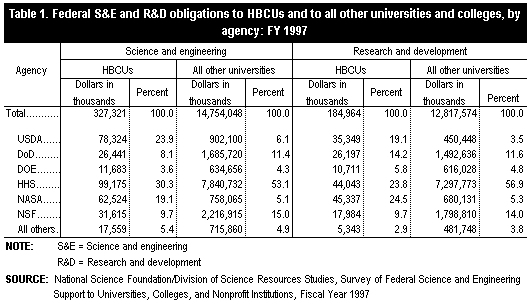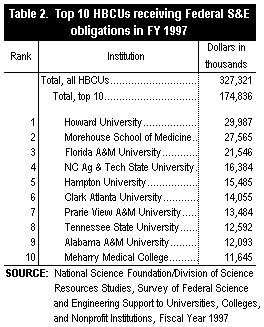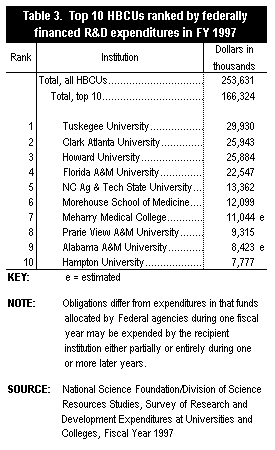
Directorate for Social, Behavioral
and Economic Sciences
NSF 99-356 August 26, 1999

Eighty-two HBCUs received Federal S&E obligations in fiscal year (FY) 1997 that totaled $327 million, resulting in a 14-percent increase from FY 1996.
Howard University, with $30 million in total S&E support and $24 million in R&D funds, was the leading HBCU recipient in terms of both S&E and R&D obligations for the sixth time in the last eight years.
The Higher Education Act of 1965, as amended, defines a Historically Black College and University (HBCU) as "...any historically black college or university that was established prior to 1964, whose principal mission was, and is, the education of black Americans, and that is accredited by a nationally recognized accrediting agency or association determined by the Secretary [of Education] to be a reliable authority as to the quality of training offered or is, according to such an agency or association, making reasonable progress toward accreditation." The White House Initiative on HBCUs, established in 1980, was "...designed to provide a structured effort to help HBCUs to access federally funded programs." The Initiative lists 104 such institutions, most of which are located in the Southeastern states, the District of Columbia, and the Virgin Islands. Most are more than a century old.
Not all HBCUs have science and engineering (S&E) programs. Eighty-two HBCUs received Federal S&E obligations in fiscal year (FY) 1997 that totaled $327 million, resulting in a 14-percent increase from FY 1996, according to the Survey of Federal S&E Support to Universities, Colleges, and Nonprofit Institutions (FSS survey). In comparison, Federal S&E support to all other academic institutions increased by 4 percent in FY 1997. The remainder of this Issue Brief summarizes statistics on HBCUs compared with all other academic institutions from three National Science Foundation (NSF) surveys: the FSS survey, which reports S&E obligations from Federal agencies; the FY 1997 Survey of Research and Development Expenditures at Universities and Colleges, which reports R&D spending by academic institutions; and the 1996 Survey of Scientific and Engineering Research Facilities at Colleges and Universities, which reports data on S&E research facilities at academic institutions.
Federal HBCU S&E Support is Less R&D-intensive
The FSS survey provides data in six S&E categories: research and development (R&D); fellowships, traineeships, and training grants; R&D plant; facilities and equipment for instruction; general support for S&E; and other S&E activities. In FY 1997, the majority of Federal S&E support to HBCUs was provided for R&D—57 percent, or $185 million. This proportion, however, was much lower than R&D's 87-percent share of the S&E support provided to other universities and colleges ($12.818 billion of an S&E amount of $14.754 billion). Federal R&D to HBCUs decreased by 2 percent in FY 1997; this was the second consecutive decline from a FY 1995 high of $203 million. On an average annual basis, however, Federal R&D support to HBCUs was up 9 percent over the FYs 1990-97 period compared with a 5-percent increase for all other academic R&D recipients (figure 1).

The miscellaneous category "other S&E activities" accounted for the second largest portion of S&E obligations at both HBCUs (17 percent, or $56 million) and non-HBCUs (6 percent, or $869 million). Over one-half (55 percent) of "other S&E activities" funding to HBCUs in FY 1997 were from the Department of Agriculture's (USDA) Cooperative State Research, Education, and Extension Service. "Other S&E activities" includes all academic S&E activities that cannot be meaningfully assigned to one of the other five S&E categories. Examples include activities in support of technical conferences, teacher institutes, and programs geared to increase the scientific knowledge of precollege and undergraduate students. The third largest funded S&E category for HBCUs was general support, accounting for 9 percent or $31 million.
Agency Mix of HBCU Support is More Diverse
The Department of Health and Human Services (HHS) accounted for approximately one-third of all Federal S&E obligations to HBCUs in FY 1997; USDA and the National Aeronautics and Space Administration (NASA) funded nearly one-fourth and one-fifth, respectively, of the HBCU S&E total. The Department of Defense (DoD) obligated 8 percent of all HBCU S&E funds, but virtually all (99 percent) of DoD's S&E obligations to HBCUs were for R&D programs (table 1).

Among all other academic institutions, HHS alone provided more than one-half of the S&E total in FY 1997. The NSF accounted for an additional 15 percent, and DoD's share was 11 percent. USDA's share (6 percent) and NASA's portion (5 percent) of total Federal academic S&E support in FY 1997 to all other academic institutions was considerably less than those two agencies' shares of the HBCU S&E amount.
USDA's significantly larger share of HBCU S&E support as compared to its share of non-HBCU S&E obligations is a reflection of the predominance of land grant colleges among HBCUs. Twenty-two of the 104 HBCUs, but less than 90 of the roughly 1,100 non-HBCU institutions receiving Federal S&E support, are land grant colleges. NASA's emphasis on HBCU support may be partly because of its Minority University-Space Interdisciplinary Network (MU-SPIN) project, a comprehensive educational initiative focusing on the transfer of advanced computer networking technologies to HBCUs and other minority universities in support of strengthening the schools' multi-disciplinary research capabilities.
Ten HBCUs Receive Most S&E Funds
Of the 82 HBCU recipients of S&E obligations in FY 1997, 58 showed current-dollar increases over their FY 1996 levels. The top 10 HBCU recipients in FY 1997 accounted for 53 percent of all HBCU S&E support, and the top 10 HBCUs receiving R&D funds accounted for 61 percent of all HBCU R&D support. Howard University, with $30 million in total S&E support and $24 million in R&D funds, was the leading HBCU recipient in terms of both S&E and R&D obligations for the sixth time in the last eight years, according to the Federal agencies that provide the funds (table 2).

Data from another NSF survey, the FY 1997 Survey of Research and Development Expenditures at Universities and Colleges, show that almost all of the HBCUs that lead in terms of Federal S&E support also lead in terms of federally financed R&D expenditures. Together, these latter top 10 institutions accounted for 66 percent of the $254 million total of all HBCU federally financed R&D expenditures (table 3). The federally financed portion of R&D expenditures dominates the HBCU funding total, accounting for 88 percent of FY 1997 total R&D spending at these institutions. Institution funds accounted for only 5 percent of the HBCU total; state and local government funds accounted for 4 percent; industry, 2 percent. For all other non-HBCU institutions, the Federal share of total R&D funding was substantially less—59 percent.

Federal Support for R&D Facilities Low at HBCUs and Non-HBCUs
According to a third NSF survey, the 1996 Survey of Scientific and Engineering Research Facilities at Colleges and Universities, in the latest 2 academic years available (1992-93 and 1994-95), funding for construction of research facilities at HBCUs totaled $30 and $21 million, respectively. The Federal Government was the source of 16 percent in each academic year. State and local governments provided 78 percent of the 1992-93 construction total and 79 percent of the 1994-95 total. The dominance of state funding in research facilities construction at HBCUs, however, is not unusual for such activities. There are few Federal programs that support any type of academic facilities construction. Overall, the Federal Government provided only 7 percent ($0.203 billion) of the funds ($2.746 billion) used to construct R&D facilities at non-HBCU institutions in 1994-95, whereas state and local governments provided 42 percent ($1.164 billion) of those construction funds. Government sources, when combined (Federal and state/local), provided 94 percent of the R&D facilities' construction funds at HBCUs in 1994-95, but only 50 percent of such support at non-HBCU institutions. Other funding sources at HBCUs were institutional funds and other debt; at non-HBCU institutions they included private donations, institutional funds, tax-exempt bonds, and other debt.
Funds for the repair/renovation of research facilities totaled $10 million at HBCUs in 1992-93 and $22 million in 1994-95. The Federal Government was the source of 53 percent of these 1992-93 funds and 47 percent of 1994-95 funds. State and local governments provided 23 and 30 percent of the total in those respective years. At non-HBCU institutions in 1994-95, the Federal Government provided only 10 percent of the $1.036 billion total for repair/renovation of research facilities and state and local governments funded 25 percent. Institutional funds (42 percent) accounted for most of the remainder.
This Issue Brief was prepared by:
Richard J. Bennof
Division of Science Resources Studies
National Science Foundation
4201 Wilson Boulevard, Suite 965
Arlington, VA 22230
703-306-1772 ext. 6938
E-mail: rbennof@nsf.gov
SRS data are available through the World Wide Web (http://www.nsf.gov/statistics/). For more information about obtaining reports, contact pubs@nsf.gov. or call (301) 947-2722. For NSF's Telephonic Device for the Deaf, dial (703) 306-0090. In your request, include the NSF publication number and title, your name, and a complete mailing address.